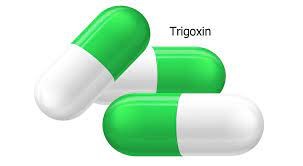Have you ever heard of the drug trigoxin, sometimes referred to as furosemide? If you haven’t heard of it, it is a drug used to treat and prevent swelling (edema) brought on by conditions such as liver illness, heart failure, and renal disease. Hypertension, often known as high blood pressure, is also treated with it. This medication can be taken alone or in conjunction with other drugs.
In addition to being accessible as a tablet and a liquid, trigoxin medicine is frequently taken alongside other prescription drugs in a single pillbox. Each version of this medication has a distinct purpose, side effects, and warnings that may cause problems if you don’t carefully follow your doctor’s instructions. In this blog, we will look out what trigoxin is used for, its side effects, and other necessary details like whether is trigoxin a real drug.
What is Trigoxin?
A drug called Trigoxin drug is used to treat heart failure. In patients receiving treatment with ACE inhibitors (angiotensin-converting enzyme inhibitors), it is also used to prevent heart failure. Trigoxin Trigoxin uses additionally to keep those who have experienced a heart attack from developing heart failure. Trigoxin comes in tablet and injectable forms.
A brand-name drug called trigoxin treats certain arrhythmias or abnormal heartbeats. Flecainide acetate, an anti-arrhythmic medication of class Ic, is the substance that gives Trigoxin its active component.
It decreases the heart’s electrical impulses, stopping it from beating excessively quickly or erratically. Trigoxin is frequently used to treat arrhythmias affecting the heart’s upper chambers, such as atrial fibrillation or atrial flutter. Other arrhythmias, like ventricular tachycardia, may also be treated with it.
Trigoxin: what is it used for?
Heart rate can be lowered using Trigoxin. On rare occasions, this medication is used to treat high blood pressure. Additionally, it has been demonstrated to help manage certain arrhythmias.
- It can also be applied to prevent the recurrence of certain infections. A quinolone antibiotic is what Trigoxin medicine is categorized as.
- It works by either destroying germs or preventing their growth. But it won’t help with the flu, the common cold, or other viral ailments.
- Trigoxin is currently only approved to treat ventricular tachycardia; however, medical professionals have found it can also help treat other arrhythmias.
- Other uses for this medication besides those listed in this medication guide are also possible.
The most common side effects of digoxin
The oral pill form of Trigoxin drug doesn’t make you sleepy. There may be other adverse effects, though.
The following are some of the more frequent side effects of digoxin:
- Diarrhea
- Dizziness
- headache
If these side effects are minor, they can disappear in a few days or weeks. However, consult your doctor or chemist if they are more severe or persistent.
Serious side effects:
Immediately call your physician if you have any serious effects. If your symptoms seem life-threatening then rush to the nearest hospital. These are some examples of side effects and associated signs:
- Allergy symptoms: Rashes on skin and swelling on the tongue and lips
- Eyesight issues: Symptoms can include a yellowish-green tinge to the eyesight.
- Mental state changing: Anxiety and hallucinations.
How long should you take trigoxin?
Usually, Trigoxin is used for three to four months. After that time, some people might be able to stop taking it, but others will need to take a lower dose for an additional three months. If you need clarification on whether you belong in one of these categories, your doctor can help. Instead of stopping trioxin abruptly, your doctor will gradually lower your dosage until you are completely off the drug.
What are the alternatives to trigoxin?
Trigoxin uses to treat angina, which results in discomfort and chest pain. Its primary ingredient, sodium nitroprusside, relaxes blood vessels and lowers blood pressure. Additionally, it is frequently used to treat hypertension. Doctors may also prescribe beta-blockers like metoprolol or nadolol. Angina can be treated with other drugs, including reserpine. Diuretics like furosemide or spironolactone could be suggested if you have heart failure.
In addition to prescribing trigoxin for hypertension, your doctor might advise lifestyle changes like losing weight and exercising to help lower your blood pressure.
Furthermore, alpha-blockers, calcium channel blockers, ACE inhibitors, angiotensin II receptor antagonists, and ramipril treat high blood pressure.
Also Read My Journey with Lupron: Navigating Lupron Long-term Side Effects and Unforeseen Challenges
Applications for digoxin digoxin
Three different dosages of digoxin are offered in three different formulations:
- Tablets: 62.5, 125, 187.5, and 250 micrograms (mcg)
- Oral remedy: 0.05 mg (50 mcg) dosage per milliliter (mL).
- Adults receive an IV injection of 0.5 mg (500 mcg) every 2 mL dose, whereas children receive 0.1 mg (100 mcg) per 2 mL dose.
Age, weight, kidney function, drugs are taken, and any antecedent medical issues all influence dosage. Digoxin administered intravenously should only be used in extreme cases or when a patient cannot take oral medication. Digoxin therapeutic levels are barely above toxic levels.
The total daily dose of trigoxin is expressed in micrograms (mcg) per kilogram of body weight (kg/day) for adults and children. Digoxin is often recommended as a loading dosage for treating atrial fibrillation, with treatment commencing at a low dose and gradually increasing until clinical goals are attained. This makes it easier to check for toxicity while figuring out the ideal amount for each person. However, there is no need for a loading dose in heart failure.
The maintenance dose is administered once daily once the clinical goals have been reached. Therefore, children under six should divide their daily dose and take their prescriptions twice daily.
Is trigoxin a real drug or not?
Trigoxin is a drug created for the movie. However, other types of drugs can have comparable effects. For example, Digoxin pills are comparable to Trigoxin pills because they strengthen and perform better in the heart.
Conclusion:
Trigoxin medicine should never be used to treat minor illnesses and should only be used as a last option. While taking trigoxin medicine, call your doctor immediately if you experience blurred vision, sudden dizziness, disorientation, lack of coordination, convulsions, chest discomfort, or trouble breathing. It’s critical to comprehend how it functions, how much to take, and any potential side effects.
Also Read: Doxycycline Ruined My Life


